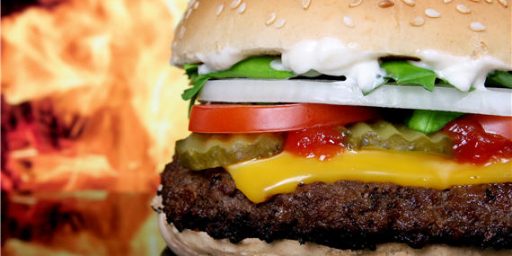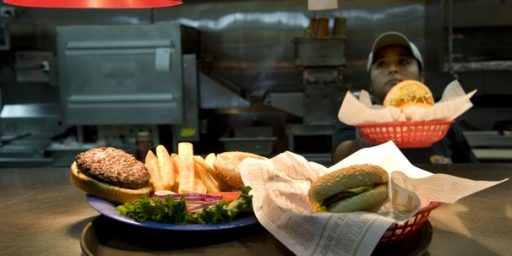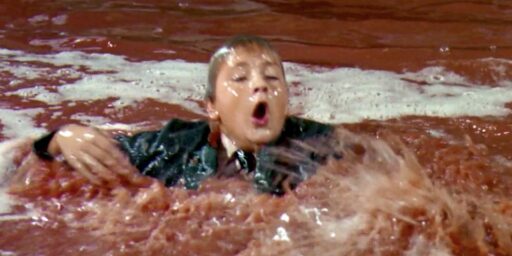Military Looking for Perfect Peanut Butter Sandwich
The military’s top scientists are working on a problem as old as warfare itself: How to make a peanut butter and jelly sandwich that will stay fresh for two years.
Combat Feeding chefs hunt elusive prey: PB&J (Chicago Sun-Times)
Making a peanut-butter-and-jelly sandwich is easy. But developing one that will remain stable under battlefield conditions has become a monumental task for scientists at the Defense Department’s Combat Feeding Directorate.
Researchers at the Natick, Mass., center, which develops food for soldiers, have been working since the early 1990s to develop shelf-stable “pocket sandwiches” similar to those found in the frozen-food aisle of grocery stores. Barbecued chicken was easy enough. So were beef pockets, an Italian-style pocket, even a french-toast pocket — all of which are supposed to be ready to be included in soldiers’ “first-strike rations” by 2007.
But what soldiers keep asking for is a classic PB&J. And that, as it turns out, has been a problem. “You would think that would be the simplest,” says Michelle Richardson, a food technologist for the U.S. military. The problem is the peanut butter. It sucks moisture out of the bread, making it dry. Richardson’s team is looking for a way to add “barriers” to the surface of either the peanut butter or the bread, in hopes that would hold in enough moisture to make the sandwich taste the way a PB&J should, without promoting bacterial growth.
[…]
A typical 2,500-calorie ration might include two pocket sandwiches, a side of applesauce, an energy bar and a beverage — less weight and volume than an MRE, but still packed with nutrients, according to Richardson. MREs keep for three years at 80 degrees and are eaten with a spoon. The pocket sandwiches can last two years, Richardson says, but they have the advantage of requiring no utensils.
The quality of military field rations has improved markedly over the last twenty years. As a cadet in the summer of 1984, I had the privilege of consuming some of the very first MREs. My introductory envelope contained something called “dehyrated pork patty” (or, perhaps, “patty, pork, dehydrated”). It was not as tasty as it sounds.
Update:
I’ve actually found a site with the History of MREs.
The MRE was adopted as the Department of Defense combat ration in 1975. A large-scale production test began in 1978 with delivery in 1981. MRE I (1981) was the first date of pack.
In 1983, a field evaluation was conducted with the 25th Infantry Division for 34 days. They ate noting but MREs three times a day. Although troops rated the ration as acceptable, consumption was low – only about 60% of the calories provided were consumed.
Another test in 1986 with the same division resulted in increased consumption and acceptance.
Based on these tests, a significant number of changes were made to MREs starting with the 1988 MREs (MRE XVIII). 9 of the 12 entrees were replaced with new ones and the entree size was changed from 5oz. to 8oz. Commercial candies were added to 4 menus, hot sauce was added to 4 menus, and cold beverage bases were added to all 12 menus.
After further field testing and as a result of early feedback from Operation Desert Storm, even more changes were made starting with MRE X: commercial freeze-dried coffee replaced the old mil-spec spray-dried coffee, hot sauce was added to all 12 menus, wet pack fruit replaced dehydrated fruits, and commercial candy was included in 4 more menus (for a total of 8).
During Operation Desert Storm, MREs were eaten by troops for far longer than they were originally intended. Originally intended for 10 days or less, many troops ate them for 60+ days. As a result, three changes were quickly made to supplement the MREs and enhance their acceptability: shelf-stable bread in an MRE pouch was developed, a high-heat-stable chocolate bar was developed that wouldn’t melt in the desert heat (this had been attempted before but the bar had a waxy taste and wasn’t widely accepted), and flameless ration heaters were developed as a quick and easy method for troops to heat their entrees.
Over the next few years, more changes took place. A joint panel recommended replacing at least two menus a year to improve acceptability, various entrees were change, and various other parts (deserts, tea/coffee, etc.) were changed.
In the first quarter of 1994, three major changes were field tested: 1) commercial-like graphics were added (studies showed commercial packaging increased comsumption and acceptance), 2) MRE bags and components were made easier to open, and 3) biogradable spoons were added to make MREs more environmentally friendly (the spoons were also longer which made them easier to get to the food). These changes will probably be implemented in MRE XVII (I think they changed in 1996 instead).
In 1994, they began to study the effects of increasing the number of available menus from 12 to 18 to 24 to overcome menu monotony and to allow MREs to be used for longer periods of time.
In 1996, the menu count was increased to 16. Then in 1997, the menu count was further increased to 20. Finally, in 1998, the menu count was increased to 24, where it remains today (2003).
Since MRE XIII (1993 Date-of-Pack [DOP]), 70 new items have been approved as MRE improvements. Fourteen of the least acceptable items were replaced, and the number of menus was increased from 12 to 24. In addition, four vegetarian meals are now included.
FAS has additional information:
MRE XIII/IV 1993 & 1994 Production
MRE XIII/IV began an intense period of improvements; two new entrees replaced older entrees, and new snack foods, pound cake and flameless ration heaters were added.
IN: Smoky franks, Pork chow mein, Pound cakes (five types), Chow mein noodles (NDI*), Potato sticks (NDI), Fruit-wet pack (peaches, pears), Sugar free beverage-in-6 menus (NDI), Heat stable chocolate bar (NDI), Flameless Ration Heaters in each menu bag
OUT: Meatballs w/tomato sauce, Chicken ala king, Nut cakes, Beverage base/sugarMRE XV 1995 Production
MRE XV had two new entrees to replace lower rated entrees, tavern nuts and lemon tea were introduced and the brownie was improved.
IN: Grilled chicken (NDI), Chili macaroni, Fruit-wet pack (pineapple, mixed), Chewy fudge brownie, Lemon tea-in 6 menus (NDI), Tavern nuts (NDI)
OUT:Corned Beef Hash, Omelet with ham, Fruit-freeze dried, Chocolate covered brownie, Coffee (six menus)MRE XVI (16 Menus) 1996 Production
MRE XVI added four new entrees, including NDI, vegetarian and ethnic selections, as well as two new starches and jalapeno cheese spread.
IN: Grilled beef steak, Chicken parmesan (NDI), Pasta primavera (Vegetarian) (NDI), Cheese tortellini (Vegetarian) (NDI), Mexican rice, White rice, butter flavored, Jalapeno cheese spread (NDI), New easy-open meal bag with graphics, Two-sided nutritional insert
OUT: Potatoes au GratinMRE XVII (20 Menus) 1997 Production
MRE XVII introduced five new entrees with only one replacement, increasing variety to 20 menus. Many new commercial NDI snack items, such as pretzels, corn chips and cheese curls were added as well as new beverages and beef jerky.
IN: Jamaican pork chop/noodles (NDI), Beef w/mushroom gravy, Beef ravioli (NDI), Turkey breast w/potatoes (NDI), Chicken w/noodles (NDI), Fig bars (NDI), Snacks-corn chips, cheese curls, pretzels (NDI), Fruit flavored hard candy (individually wrapped) (NDI), Fruit flavored disc candy (NDI), Peanut bar (NDI), Apple cider beverage (NDI), Beef jerky (NDI), Strawberry jam (NDI)
OUT: Escalloped potatoes w/hamMRE XVIII (24 Menus) 1998 Production
MRE XVIII completed the move to 24 different menus with the addition of four ethnic style entrees. Many new starches, snacks and a new vegetable cracker were added.
IN: Beef teriyaki, Spicy oriental chicken (NDI), Chicken strips in salsa, Meat loaf w/brown gravy (NDI), Black bean and rice burrito (Vegetarian) (NDI), Pasta w/vegetables in Alfredo sauce (Vegetarian) (NDI), Buttered noodles, Granola bars – chocolate chip, honey nut (NDI), Fruit filled bars (NDI), Cinnamon apples (NDI), Apple cinnamon toaster pastry (NDI), Snack mix (NDI), Shortbread cookies (NDI), Chewy chocolate bar (NDI), Vegetable cracker, Tea bag (NDI)
OUT: Pork w/rice in BBQ sauce, Tuna w/noodlesMRE XIX (24 Menus) 1999 Production
MRE XIX had one new entree and three snacks introduced MRE XX added two new entrees, three soups/starches, two nutrient infused fruits and three snacks.
IN: HooAH!(TM) Bar, Ergo Beverage, Flat Bread (NDI), Lemon Poppyseed Pound Cake (NDI), Raisin Nut Mix, Beef Enchilada (if needed) (NDI), Turkey Tettrazini (if needed) (NDI)OUT: None
Not sure why they got rid of the meatballs; they were my favorite meal. Maybe the newer meals made them less desirable by comparison.





Never had them in the Army, but we ate our share in the Boy Scouts. God, some of those were awful. But they’re really not too bad anymore. I’m not sure I’d go so far as to say that they’re great, but they’re stomachable. It’s really pretty impressive how far they’ve come in 20 years, and even more so how long they’ll keep.
You were lucky.
A decade previous to your experience I was in the CCF (like a UK version of a Junior ROTC maybe) and we were fed, when out on exercise, on Korean War surplus bully beef. Exaclty as wonderful as it sounds.
(OK, cue the Monty Python sketch for the next guy to complain I had it easy).
Oh man, I *loved* pork and beef patty MREs, and would trade for them. Soak it up in water for a long time, then wrap it in foil and leave it on your deuce and a half engine block for about 30 miles, put on bread and add mustard and squeezy cheese. Mmm!
I always loved opening the cans of water in lifeboat survival kits from the 50’s when I inventoried them to see what the heck water that was 40 years old smeled like.